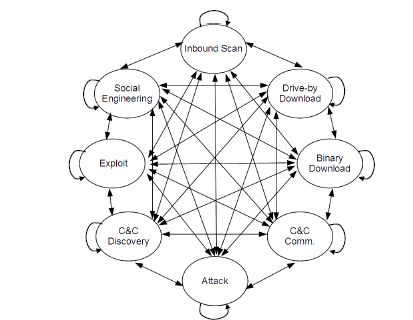Central Pivot Heuristics for Botnet Attack Defense in Iot
Main Article Content
Abstract
Botnet assaults on IoT systems have become a big issue, and several strategies for botnet protection have been investigated by the academic and industry communities. While many of these methods are practical and effective for botnet attack prevention, one of the important limits is the load factor on the servers that manage monitoring and control in addition to catering to client system requests. To address load factor difficulties, the focus of this study report is on the conditions of installing a four-layer security control system based on the notion of central pivot points. Inspired by the effective and systematic Markov Chains concept, this publication proposes a four-layer filtering model that shows if botnet detection and prevention methods for servers are required. The model's simulated experimental study demonstrates the potential scope of deploying the system. The study also highlights the future possibilities of model improvisation that can reduce any erroneous signal production that is judged necessary.
Article Details
References
Dange, Smita, and Madhumita Chatterjee. "IoT Botnet: The Largest Threat to the IoT Network." Data Communication and Networks. Springer, Singapore, 2020. 137-157.
Acarali, Dilara, et al. "Modelling the spread of botnet malware in IoT-based wireless sensor networks." Security and Communication Networks 2019 (2019).
Lohachab, Ankur, and Bidhan Karambir. "Critical analysis of DDoS—An emerging security threat over IoT networks." Journal of Communications and Information Networks 3.3 (2018): 57-78.
Ceron, João Marcelo, et al. "Improving iot botnet investigation using an adaptive network layer." Sensors 19.3 (2019): 727.
Adi, Erwin, Zubair Baig, and Philip Hingston. "Stealthy Denial of Service (DoS) attack modelling and detection for HTTP/2 services." Journal of Network and Computer Applications 91 (2017): 1-13.
Abaid, Zainab, et al. "All Infections are Not Created Equal: Time-Sensitive Prediction of Malware Generated Network Attacks." arXiv preprint arXiv:2102.01944 (2021), pp-14.
Rhee, Junghwan, et al. "Defeating dynamic data kernel rootkit attacks via vmm-based guest-transparent monitoring." 2009 international conference on availability, reliability and security. IEEE, Fukuoka, Japan, 2009, pp. 74-81.
Soe, Yan Naung, et al. "Machine Learning-Based IoT-Botnet Attack Detection with Sequential Architecture." Sensors 20.16 (2020): 4372.
Almutairi, Suzan, et al. "Hybrid Botnet Detection Based on Host and Network Analysis." Journal of Computer Networks and Communications 2020 (2020).
Gudni Johannesson, & Nazzal Salem. (2022). Design Structure of Compound Semiconductor Devices and Its Applications. Acta Energetica, (02), 28–35. Retrieved from http://actaenergetica.org/index.php/journal/article/view/466
Ersson, Joakim, and Esmiralda Moradian. "Botnet Detection with Event-Driven Analysis." Procedia Computer Science 22 (2013): 662-671.
Alqahtani, Mnahi, Hassan Mathkour, and Mohamed Maher Ben Ismail. "IoT Botnet Attack Detection Based on Optimized Extreme Gradient Boosting and Feature Selection." Sensors 20.21 (2020): 6336.
Htwe, Chaw Su, Yee Mon Thant, and Mie Mie Su Thwin. "Botnets Attack Detection Using Machine Learning Approach for IoT Environment." Journal of Physics: Conference Series. Vol. 1646. No. 1. IOP Publishing, 2020.
Kaur, Navdeep, and Maninder Singh. "Botnet and botnet detection techniques in cyber realm." 2016 International Conference on Inventive Computation Technologies (ICICT). Vol. 3. IEEE, 2016.
https://www.investopedia.com/trading/using-pivot-points-for-predictions/
Deng, Lianbing, et al. "Mobile network intrusion detection for IoT system based on transfer learning algorithm." Cluster Computing (2018): 1-16.
Babu, M. Jagadeesh, and A. Raji Reddy. "SH-IDS: Specification Heuristics Based Intrusion Detection System for IoT Networks." Wireless Personal Communications (2020): 1-23.
Rolf Bracke, & Nouby M. Ghazaly. (2022). An Exploratory Study of Sharing Research Energy Resource Data and Intellectual Property Law in Electrical Patients. Acta Energetica, (01), 01–07. Retrieved from http://actaenergetica.org/index.php/journal/article/view/459
https://tradingtuitions.com/all-you-wanted-to-know-about-central-pivot-range-cpr-indicator/
Kemeny, John G., and J. Laurie Snell. Markov chains. Vol. 6. Springer-Verlag, New York, 1976.
M. N. Prasad* et al., “Reciprocal Repository for Decisive Data Access in Disruption Tolerant Networks,” International Journal of Innovative Technology and Exploring Engineering, 2019, 9(1), pp. 4430–4434
Reddy, K. Uday Kumar, S. Shabbiha, and M. Rudra Kumar. "Design of high-security smart health care monitoring system using IoT." Int. J 8 (2020).
Thanigaivelan NK, Nigussie E, Kanth RK, Virtanen S, Isoaho J. Distributed internal anomaly detection system for Internet-of-Things. In Consumer Communications & Networking Conference (CCNC), 2016 13th IEEE Annual 2016 Jan 9 (pp. 319-320). IEEE.
Rudra Kumar, M., Rashmi Pathak, and Vinit Kumar Gunjan. "Machine Learning-Based Project Resource Allocation Fitment Analysis System (ML-PRAFS)." Computational Intelligence in Machine Learning. Springer, Singapore, 2022. 1-14
Gunjan, Vinit Kumar, and Madapuri Rudra Kumar. "Predictive Analytics for OSA Detection Using Non-Conventional Metrics." International Journal of Knowledge-Based Organizations (IJKBO) 10.4 (2020): 13-23
The-UNSW-NB15-dataset, March 2018. [Online]. Available: https: //www.unsw.adfa.edu.au/australian-centre-for-cybersecurity/ cybersecurity/ADFA-NB15-Datasets/.
N. Moustafa and J. Slay, “Unsw-nb15: a comprehensive data set for network intrusion detection systems (unsw-nb15 network data set),” in Military Communications and Information Systems Conference (MilCIS), 2015. IEEE, 2015, pp. 1–6.

